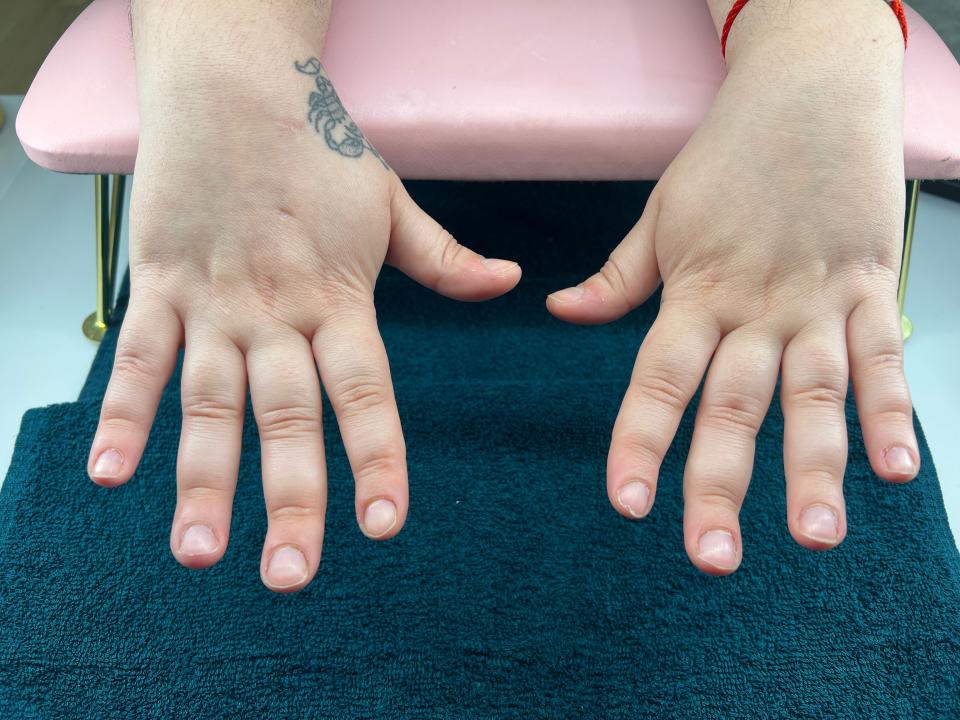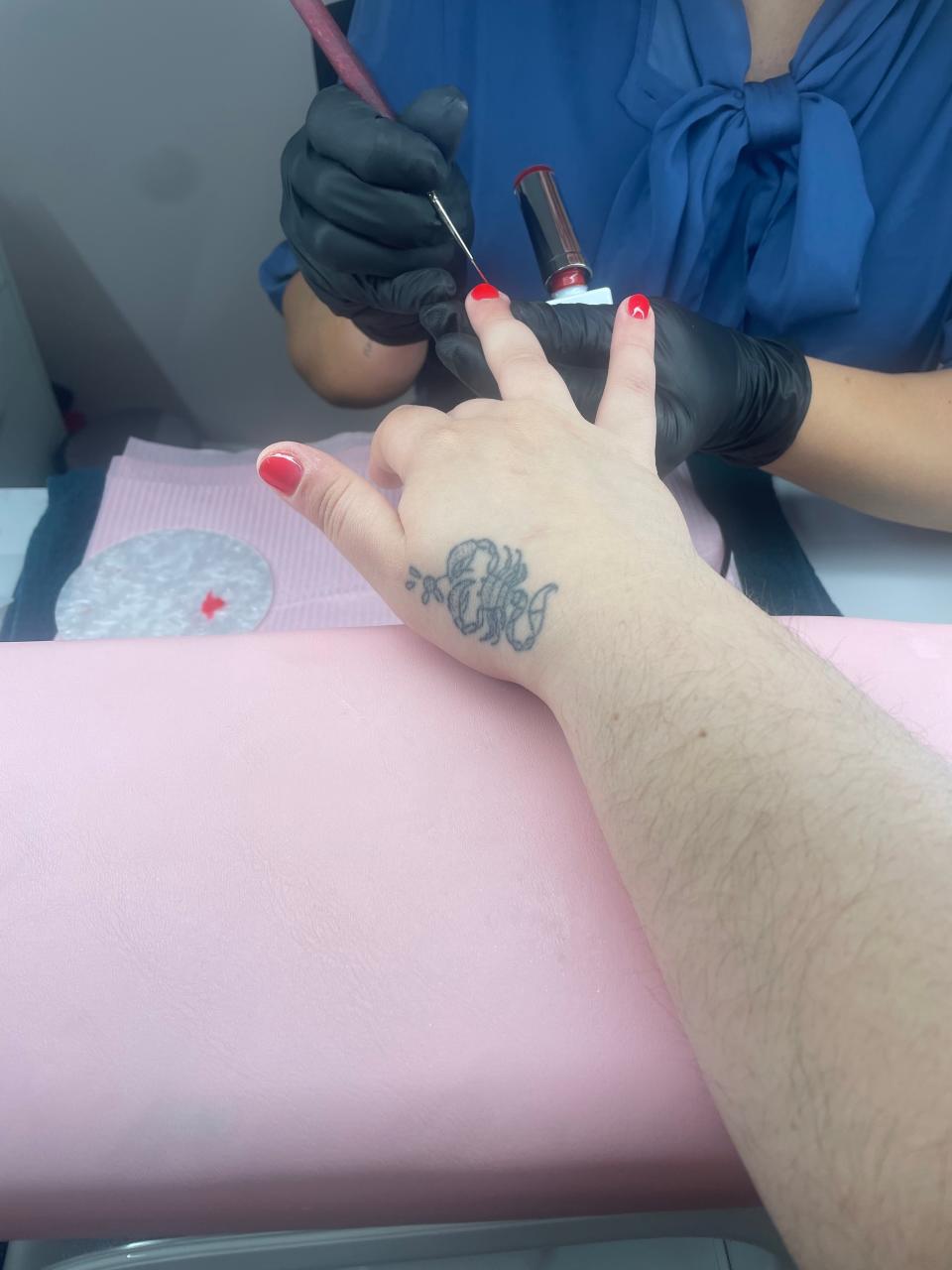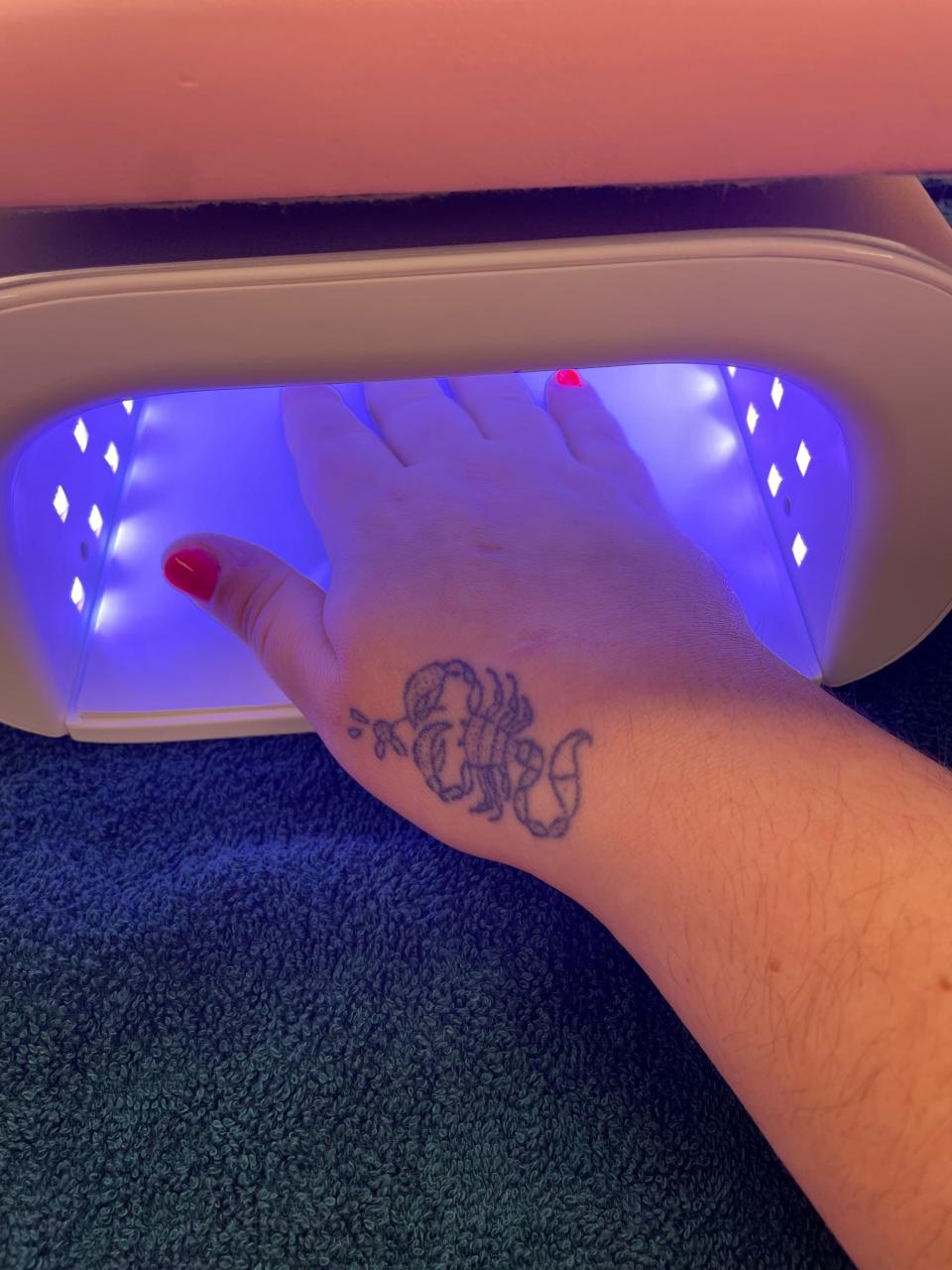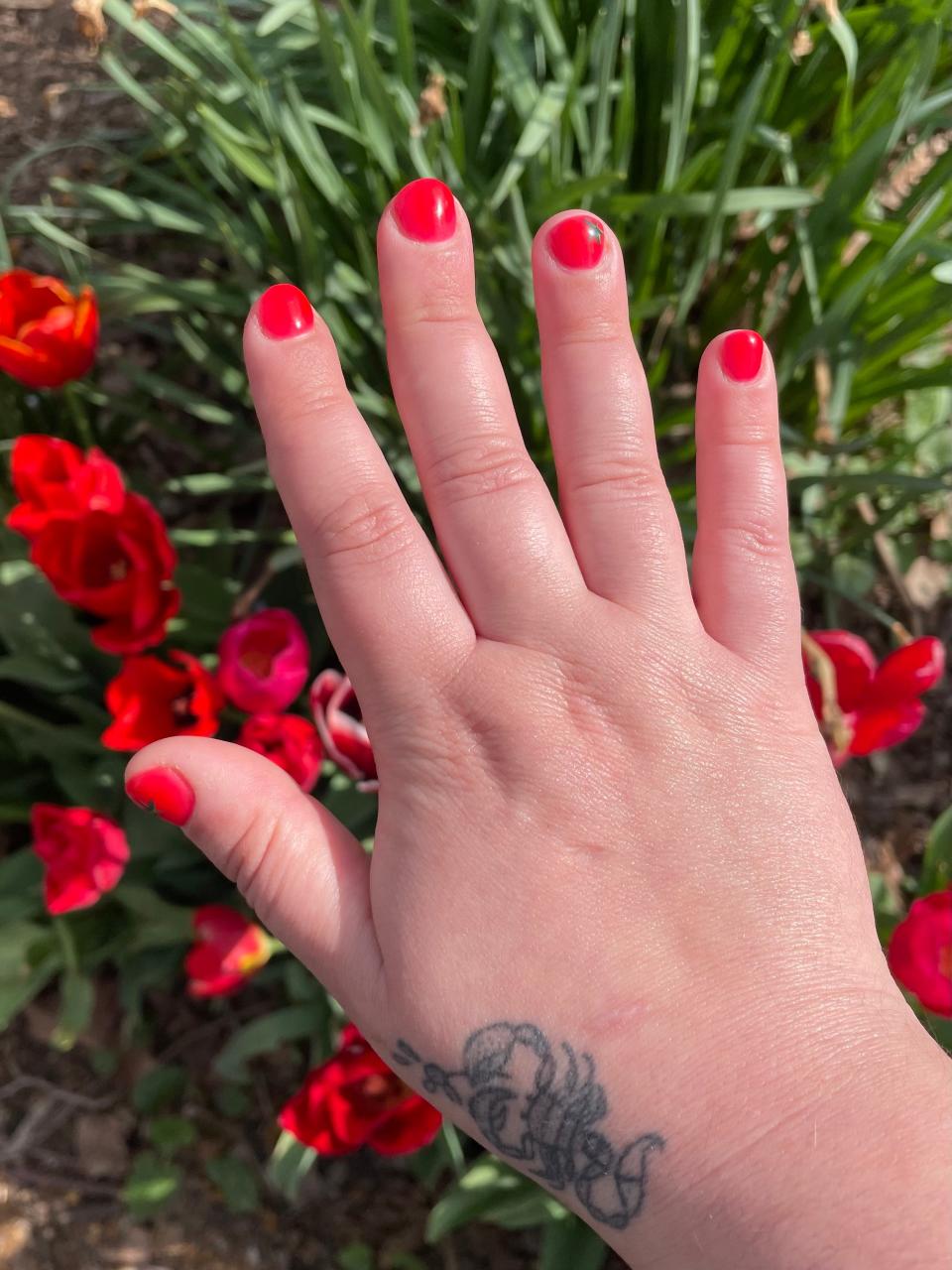I Tried BIAB Nails, the Manicure Dubbed “Armor For Your Nails”

Design by Bella Geraci, Devon Abelman
Before getting BIAB nails, I was disillusioned with nail salons. Regular polish chipped the second I left the salon. Gel manicures always chip on me, plus they tend to tear off the top layers of my nails in the removal process (so acrylics were definitely out of the question). BIAB, however, was able to reel me back in after a six-month sabbatical of manicures.
BIAB is the abbreviation for Builder in a Bottle, a formula from nail-care brand The Gel Bottle. It’s risen to TikTok fame over the last year or so—not only for its unparalleled durability (the brand claims it lasts at least four weeks) but also for how it supports healthy nail growth. It’s become a major nail trend in Europe, particularly the U.K., and is poised to take over tips stateside.
Curious about what BIAB nails were all about, I visited manicurist Julie Kandalec at her “Nail Artelier” in New York City to try it out. Kandalec has reached for BIAB for the last four years when working with her celebrity clients, like Pink and Jessica Chastain. Read on to learn more about the benefits of getting a BIAB manicure and my experience with it.
Meet the experts:
Anissa Campos is a nail artist based in Chicago.
Julie Kandalec is a New York City-based manicurist.
Mona Gohara, MD, is a board-certified dermatologist and associate clinical professor of dermatology at Yale School of Medicine in Connecticut.
Giorgia Cappella is a UK-based nail tech and the head educator at The Gel Bottle.
Kelly Dobos is a cosmetic chemist in Cincinnati.
What are BIAB nails?
BIAB is a thick, viscous, multitasking builder gel. Typical builder gel is housed in a pot and used for reinforcing weak nails. It’s often topped with classic gel polish to add color and designs for a structured or hard gel manicure. BIAB, on the other hand, combines the effects of primer, base coat, builder gel, and color into one bottle Kandalec says. “BIAB is strong and durable like acrylic manicures but provides a lightweight, natural finish like gel,” she adds.

The GelBottle Inc Builder in a Bottle in Love BIAB
$21.00, The GelBottle Inc
Available in over 50 colors, many BIAB polishes are soft nudes and pastel pinks. “Most [of my] BIAB clients tend to lean towards the more dainty and natural look,” Chicago-based nail artist Anissa Campos says. “But you can also add all sorts of embellishments to your BIAB manicure, such as charms, chrome powder, and airbrush [designs].”
BIAB is for professional use only. You must be a licensed nail tech to purchase a bottle, so you’ll need to visit a salon for a BIAB manicure if you’re not.
What are the benefits of a BIAB manicure?
Daily tasks like typing, household chores, and workout classes can weaken nails over time. A BIAB manicure is a great option for those who want to grow, repair, and reinforce their natural nails, especially if they are brittle. “Think of BIAB as armor for your nails,” Kandalec says. “It gives your nails a protective overlay, which makes them less likely to chip or crack and more likely to grow to whatever length you desire.” Board-certified dermatologist Mona Gohara confirms this benefit, adding that strengthening natural nails and making them less likely to split or crumble is an important feature of this trendy new nail formula.
Because BIAB is thicker than the typical gel manicure, you won’t be able to bite through it, which is helpful if you’re trying to break the habit of nail-biting, Campos says. Its viscosity also helps visibly smooth ridges, splits, and discoloration.
It won’t change the actual structure of your nail, though. “It’s very difficult to smooth out ridges,” Dr. Gohara explains. “Ridges are a function of genetics, what we do to our nails, and time. In some instances, medicated topical lacquers may help [even out your nail], but it is not an easy task.”
How does a BIAB manicure compare to a gel manicure?
Both BIAB and gel manicures shield your nail plate, but Campos says the former is more durable, withstanding more of the elements life throws at it. According to Cincinnati-based cosmetic chemist Kelly Dobos, this sturdiness is thanks to a Bis(methacryloyloxyethyl) phosphate, a monomer typically used in dentistry to create fillings, bonds, sealants, and crowns that can endure the wear and tear of polishing and chewing. Gel polish, on the other hand, gets its durability from a lower, weaker concentration of monomers and oligomers, which doesn’t give nails as hard of a coating.
Another benefit of getting BIAB over gel is its ability to be filled when it’s grown out, so you don’t have to start with a blank natural nail canvas every time you visit the salon. However, the color may need to be fully removed and redone every three to four appointments to rebuild and perfect the structure of the BIAB, says Giorgia Cappella, the head educator at The Gel Bottle.
With this in mind, neither manicure is better than the other, Kandalec says. The manicure you choose simply comes down to personal preference. She does point out that “people looking to grow out their natural nails without the use of extensions will find greater success with BIAB than gel alone.”
Can I get a BIAB manicure with extensions?
Although they are more traditionally done on natural nails, you can get a BIAB manicure with extensions. The tips can be sculpted with forms or glued on as they would be for an acrylic or Gel-X manicure. “Some nail artists glue the tip on with BIAB gel instead of adhesive for longer retention,” Campos says.
My BIAB manicure experience

Before I dive into my BIAB manicure experience, allow me to tell you more about my nails. First and foremost, they’re tiny and slightly pudgy—I like to keep them short and round. Having short nails also limits the amount of damage I can wreak on my fingers when I’m anxious, as I’m a chronic cuticle picker due to dermatillomania.
Prior to trying BIAB, I’d taken a break from visiting my nail artist for my monthly gel manicures. For about six months, I either painted my nails at home with Mooncat’s Fake Halo polish or put on press-ons from Pink Friday Nails.
On the day of my manicure, I went for a look inspired by a Korean nail art trend. I kept seeing my favorite Seoul-based nail artists turn tips into tiny tomatoes by painting them a juicy, sheer red and topping them with green stars as stems. Lucky for me, The Gel Bottle has a shade called Love BIAB that is the perfect tomato-red for this look.
Step 1: Nail prep
BIAB manicures begin the same way as any other manicure: with nail prep. Kandalec got the shape of my nails and the state of my cuticles in order with some buffing and filing. Then, she dehydrated my nail beds with acetone.
Step 2: Paint the base layer.
Although you don’t need a base coat, Kandalec always paints an extra thin layer of the BIAB color onto each nail to start the process. This helps the next layer go on more seamlessly and provides a foundation for a thicker, more structured coat, she explains.
Step 3: Build up the apex.
This step of the process mesmerized me. Kandalec worked one nail at a time—painting each nail and then curing it. While that nail was under the UV-LED light, she worked on the same finger on the opposite hand. When painting the nail, Kandalec dropped a bead of the red polish onto my nail, then spread it across the center (or apex) in a zig-zag motion.
Next, Kandalec took an ultra-thin detail brush and pulled the thick gel toward the edges, so it was thinner around the cuticle and sides of the nail. This ensured my nails grew out more seamlessly without a stark gap between the cuticle and the BIAB.
Before curing the nail, Kandalex held my hand upside down. For a second, I wondered if this was a Dairy Queen-inspired test to show me that the BIAB polish is so viscous that it won’t drip. Alas, I was wrong. BIAB is self-leveling, so this motion ensured the gel flowed back toward the apex and didn’t flood the cuticle. “Building a proper apex provides better retention and extends the life of the manicure,” Kandalec says.


Step 4: Apply top coat.
Once every nail was properly BIAB-ed and cured, Kandalec finished my manicure with a high-shine gel top coat, which is necessary for sealing the product. She explained that the combination of BIAB and the top coat creates an insoluble veneer on nails for the glossiest possible final product.
My BIAB Nails

In the month since I got my first BIAB manicure, I’ve stopped negatively fixating on my nails—something I haven’t been able to do in years. The red polish looks so juicy and adorable that I can’t stop staring at my manicure in adoration. Even better, I couldn’t peel my nails down to the quick even if I tried—BIAB is rock-solid.
I also have unintentionally put my BIAB nails through durability tests. The day after getting the manicure, I built some furniture and spring-cleaned my apartment. My nails still looked as fresh as when I left the appointment. I also have a 95-pound dog that I walk several times a day and take to the dog park, and three weeks into my BIAB manicure, I tripped and randomly caught my fall fingernail first—and yet my BIAB nails are still free of chips, knicks, and cracks.
It’s an unbelievable outcome that lasted so long and helped me build a more positive relationship with my nails.
Where can I get a BIAB manicure?
The Gel Bottle is currently developing a salon finder to help you track down where to receive the best BIAB manicure in your area. In the meantime, seek out local nail artists who specifically call out BIAB as an option in their list of services.
How much do BIAB nails typically cost?
The cost of BIAB nails depends on what salon you go to and what your final look entails. A simple, one-color BIAB manicure on natural nails typically ranges from $40 to $60. The price increases with the addition of nail art, extensions, or a chrome finish.
Overall, I highly recommend BIAB to those looking for a more durable, long-lasting manicure. It creates a hard, chip-resistant shell over the surface of nails without feeling bulky or thick (a major plus for those with sensory issues). Honestly, I don’t think I could ever go back to classic gel manicures after this. In my experience, those are like wrapping your nails in aluminum foil, and BIAB is stainless steel. In the words of Daft Punk, my BIAB nails are simply harder, better—maybe not faster—but absolutely stronger.
Read more about manicures:
Now, watch Benito Skinner react to other TikTok beauty trends:
Follow Allure on Instagram and TikTok, or subscribe to our newsletter to stay up to date on all things beauty.
Originally Appeared on Allure

